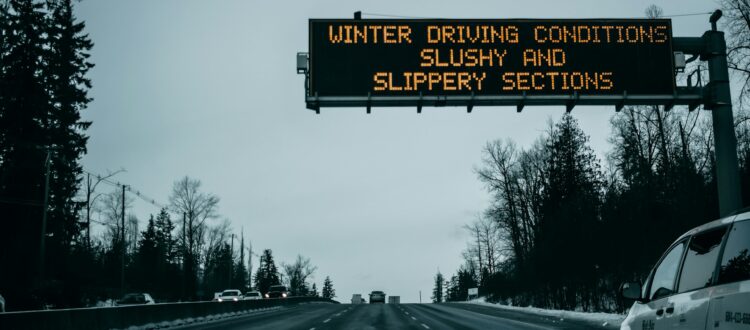Digital road signs are a modern innovation revolutionizing the way we communicate important information to drivers and pedestrians on the road. These signs utilize electronic displays to convey real-time traffic updates, weather conditions, emergency alerts, and other vital information to ensure safer and more efficient travel.
By integrating cutting-edge technology with traditional road signage, they offer a dynamic and adaptable approach to keeping road users informed and aware of changing circumstances. With their ability to display multiple messages and adapt to different traffic situations, they are becoming an integral part of modern transportation infrastructure, enhancing road safety and communication for all travelers.
What are the Digital Road Signs Called?
 The digital road signs are commonly referred to as Variable Message Signs (VMS) or Dynamic Message Signs (DMS). These signs are equipped with electronic displays that can change messages in real-time, providing up-to-date information on traffic conditions, road closures, weather alerts, and other important notices.
The digital road signs are commonly referred to as Variable Message Signs (VMS) or Dynamic Message Signs (DMS). These signs are equipped with electronic displays that can change messages in real-time, providing up-to-date information on traffic conditions, road closures, weather alerts, and other important notices.
Variable Message Signs are designed to adapt to changing circumstances, making them a valuable tool for transportation authorities to communicate with drivers and improve overall road safety. With their ability to display dynamic information, these digital road signs play a crucial role in modern traffic management systems and are instrumental in keeping road users informed and prepared for various situations.
How Do Digital Road Signs Work?
They work by utilizing electronic displays, such as LED or LCD screens, to convey information to drivers and pedestrians. These signs are often connected to a central control system that can remotely update the displayed messages in real-time. The control system can receive input from various sources, including traffic sensors, weather monitoring equipment, and emergency response agencies, allowing the digital road signs to display relevant and timely information.
Also, some digital road signs are equipped with built-in sensors and cameras that can detect traffic flow, weather conditions, and incidents, enabling the signs to automatically adjust their messages to provide the most accurate and helpful information to road users. With their dynamic capabilities, they improve communication on the road and contribute to safer and more efficient travel experiences for everyone.
What is the Technology for Digital Road Signs?
 The technology behind these signs typically involves the use of LED (Light Emitting Diode) or LCD (Liquid Crystal Display) screens to display messages and information. These signs are often connected to a central control system, which can be operated remotely to update the displayed content. This control system can receive input from various sources such as traffic management centers, weather monitoring systems, and emergency response agencies, allowing the digital road signs to adapt their messages based on real-time data.
The technology behind these signs typically involves the use of LED (Light Emitting Diode) or LCD (Liquid Crystal Display) screens to display messages and information. These signs are often connected to a central control system, which can be operated remotely to update the displayed content. This control system can receive input from various sources such as traffic management centers, weather monitoring systems, and emergency response agencies, allowing the digital road signs to adapt their messages based on real-time data.
Also, some advanced digital road signs are equipped with built-in sensors, cameras, and communication modules that enable them to detect traffic flow, monitor weather conditions, and receive emergency alerts, enhancing their ability to provide relevant and accurate information to road users.
The technology used for digital road signs is continually evolving to incorporate more advanced features such as solar power integration, wireless communication, and energy-efficient displays. These advancements aim to improve the sustainability, reliability, and versatility of digital road signs, making them an essential component of modern transportation infrastructure. With ongoing innovation, they are expected to become even more adaptive, interactive, and effective in communicating crucial information to road users, ultimately contributing to safer and more efficient travel experiences.
Who Regulates Digital Road Signs?
Their regulation often falls under the jurisdiction of transportation departments, local authorities, and government agencies responsible for managing road infrastructure and traffic control. These entities establish guidelines, standards, and policies for the installation, operation, and maintenance of digital road signs to ensure consistency, safety, and effectiveness. In many cases, regulations regarding these signs are set forth in collaboration with industry standards and best practices to promote uniformity and compliance.
In addition, regulatory bodies often oversee the approval process for the content displayed on digital road signs, particularly when it comes to critical information such as emergency alerts, traffic advisories, and safety messages. By regulating them, authorities aim to uphold the integrity and reliability of these essential communication tools while prioritizing the safety and well-being of road users.
Do Digital Road Signs Required to be MUTCD-Compliant?
Yes, they are required to be MUTCD (Manual on Uniform Traffic Control Devices) compliant in the United States. The MUTCD sets forth the standards for traffic control devices, including signs, signals, and pavement markings, to ensure uniformity and consistency in traffic control practices across the country. Digital road signs must adhere to the guidelines outlined in the MUTCD to guarantee that the messages displayed are clear, recognizable, and effectively communicate important information to road users. Compliance with the MUTCD standards helps to maintain the safety, functionality, and reliability of digital road signs, contributing to a cohesive and organized traffic management system.
What Kinds of Digital Road Signs are Available?
1. Variable Message Signs (VMS)
- Display real-time information
- Convey traffic conditions, travel times, and emergency alerts
2. Dynamic Message Signs (DMS)
- Offer customizable messages
- Address specific situations such as road closures, construction updates, and weather advisories
3. Lane Control Signs
- Manage traffic flow
- Indicate Lane status, speed limits, or lane closures
4. Variable Speed Limit Signs
- Dynamically adjust speed limits
- Based on traffic conditions and weather, enhancing safety and traffic efficiency
5. Portable Changeable Message Signs (PCMS)
- Temporary digital signs
- Used for short-term notifications such as detours, event parking, or work zone warnings
What are the Advantages of Digital Road Signs?
1. Flexibility and Adaptability
- Can be adjusted to current traffic conditions at any time.
- Controlled centrally from a distance and automatically.
- Improves traffic safety and minimizes traffic jams and obstructions in the road system.
2. Rapid Response to Unforeseen Events
- Can quickly respond to accidents by rerouting traffic within seconds.
- Allows quick adjustments in the event of road closures, providing alternative routes to avoid traffic jams.
- Plays a crucial role in disaster situations by providing routes to the nearest emergency services.
3. Flexible Traffic Control
- Offers various types of digital road signs, such as Variable Message Signs (VMS), Dynamic Message Signs (DMS), Lane Control Signs, Variable Speed Limit Signs, and Portable Changeable Message Signs (PCMS) to address different traffic management needs and communication purposes.
Where are Digital Road Signs Used?
 They are used in various locations and settings to enhance traffic management, communication, and safety. These signs are commonly deployed on highways, expressways, and major roadways to provide real-time information about traffic conditions, travel times, and emergency alerts. Also, they are utilized at significant intersections, parking entrances, and above electric vehicle (EV) charging stations to inform drivers about the availability of charging facilities, contributing to efficient and safe navigation.
They are used in various locations and settings to enhance traffic management, communication, and safety. These signs are commonly deployed on highways, expressways, and major roadways to provide real-time information about traffic conditions, travel times, and emergency alerts. Also, they are utilized at significant intersections, parking entrances, and above electric vehicle (EV) charging stations to inform drivers about the availability of charging facilities, contributing to efficient and safe navigation.
Furthermore, these signs play a crucial role in disaster situations by providing routes to the nearest emergency services. The flexibility and adaptability of digital road signs make them valuable tools for managing traffic flow, responding to unforeseen events, and ensuring the safety and efficiency of transportation facilities.
Federal DOT to Ban Humorous or Funny Digital Road Signs
The Federal Department of Transportation (DOT) is considering a ban on humorous or funny digital road signs as part of an effort to maintain the seriousness and effectiveness of traffic communication. While some may find humor in these signs, there are concerns that humorous messages could lead to driver distraction and compromise the intended purpose of conveying critical information.
The DOT aims to prioritize the safety and clarity of traffic communication, and the use of humorous digital signs may detract from this objective. By implementing a ban on humorous or funny messages, the DOT seeks to ensure that these road signs convey only essential, clear, and non-distracting information to drivers, ultimately contributing to safer road conditions and improved traffic management.
Moreover, the potential ban by the Federal DOT is also driven by the need to maintain professionalism and consistency in public communication. The use of humor in traffic messages, while entertaining to some, can be perceived as unprofessional and may undermine the authority and credibility of important traffic information.
By prohibiting the use of humor in digital road signs, the DOT aims to maintain a standard of seriousness and professionalism in public communication, reinforcing the importance of adhering to clear, concise, and authoritative messaging on road signs. This move is intended to uphold the integrity and reliability of traffic communication, ensuring that drivers receive accurate and credible information without any potential for misinterpretation or distraction.
Are Digital Road Signs Expensive?
 They may be costly to install and maintain due to the advanced technology and infrastructure required for their operation. The initial investment for digital road signs includes the purchase of the sign itself, installation costs, and the necessary software and hardware for remote control and monitoring. Also, ongoing expenses for maintenance, repair, and software updates contribute to the overall cost of digital road signs.
They may be costly to install and maintain due to the advanced technology and infrastructure required for their operation. The initial investment for digital road signs includes the purchase of the sign itself, installation costs, and the necessary software and hardware for remote control and monitoring. Also, ongoing expenses for maintenance, repair, and software updates contribute to the overall cost of digital road signs.
However, the long-term benefits of improved traffic management, real-time information dissemination, and enhanced safety may justify the initial expenses. Furthermore, the flexibility and adaptability of digital road signs in addressing varying traffic conditions and communication needs can lead to long-term cost savings by minimizing traffic congestion, accidents, and associated expenses.
On the other hand, some argue that the benefits outweigh the initial costs. The ability to convey real-time information, manage traffic flow, and respond rapidly to unforeseen events can lead to significant improvements in traffic safety and efficiency. Also, the long-term cost savings associated with reduced traffic congestion, accidents, and enhanced emergency response may justify the initial investment in digital road signs. Therefore, while the initial expenses for digital road signs may be considered high, their long-term benefits in terms of traffic management and safety could make them a valuable and cost-effective investment for transportation authorities and road management agencies.
Conclusion
Digital road signs play a pivotal role in modern traffic management, offering unparalleled flexibility, adaptability, and real-time communication capabilities. While the initial investment and maintenance costs may be significant, the long-term benefits of improved traffic safety, reduced congestion, and rapid response to emergencies justify their implementation. As technology continues to advance, they are likely to evolve, providing even more efficient and effective solutions for managing traffic flow and enhancing road safety. GO HERE for digital traffic signs that meet the DOT and MUTCD standards.
Popular Posts:




